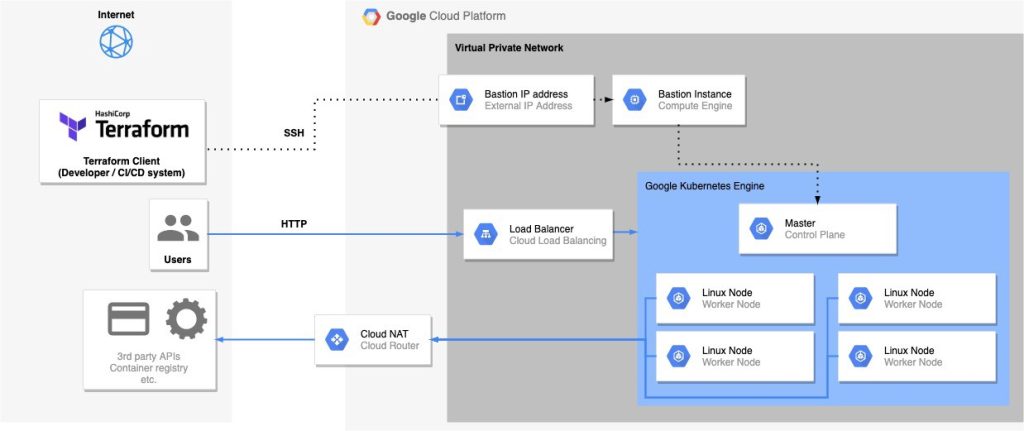MORU

Date
April 16th, 2025
Client
Individual
Services
CI/CD Automation
Cloud
GKE Cluster
Building a Scalable Kubernetes Infrastructure on Google Cloud Platform
The architecture diagram illustrates a robust Google Cloud Platform (GCP) deployment centered around Google Kubernetes Engine (GKE). This infrastructure design demonstrates how modern cloud-native applications can be deployed with security, scalability, and infrastructure-as-code principles in mind.
Key Components of the Architecture
Infrastructure Automation with Terraform
At the foundation of this architecture is HashiCorp Terraform, providing infrastructure-as-code capabilities. Terraform allows developers and operations teams to define, provision, and manage GCP resources in a programmatic, version-controlled manner. This approach ensures consistent environments and simplifies the complexities of cloud infrastructure management.
Secure Access Layer
The architecture implements a well-designed secure access pattern:
- A Bastion host with external IP address acts as the secure entry point for administrative access
- SSH connections from the Terraform client (developer environment) to the Bastion provide secure administrative access
- The Bastion instance is strategically placed within the Virtual Private Network (VPN)
Network Architecture
The design showcases a thoughtful network configuration:
- A Virtual Private Network isolates resources from direct internet exposure
- Cloud NAT enables outbound connectivity for private resources to access external services
- This allows worker nodes to communicate with third-party APIs and container registries
Kubernetes Implementation
At the core of this architecture is Google Kubernetes Engine:
- A Master node handles the control plane operations
- Multiple Linux worker nodes provide the compute capacity for containerized applications
- The worker nodes are distributed for high availability
- The cluster is accessed through a Cloud Load Balancer, which routes HTTP traffic from users
Benefits of This Architecture
This architecture delivers several important advantages:
- Security by Design: The bastion host pattern limits direct exposure to the internet, while the VPC provides network isolation.
- Scalability: GKE automatically manages the Kubernetes control plane and can scale worker nodes as demand changes.
- Infrastructure as Code: Using Terraform ensures repeatable deployments and enables GitOps workflows through CI/CD systems.
- Cost Efficiency: The architecture separates concerns appropriately, allowing resources to be sized according to their specific requirements.
- Operational Excellence: The design provides clear separation between user traffic, administrative access, and backend services.
Implementation Considerations
When implementing this type of architecture, consider:
- Setting up appropriate IAM roles and permissions for the Terraform service account
- Configuring network policies within Kubernetes for pod-to-pod communication
- Implementing secrets management for sensitive configuration
- Establishing monitoring and logging solutions to gain visibility into the infrastructure
This architecture represents a modern approach to cloud-native application deployment that balances security, scalability, and operational efficiency—ideal for organizations looking to leverage container orchestration while maintaining robust infrastructure governance.